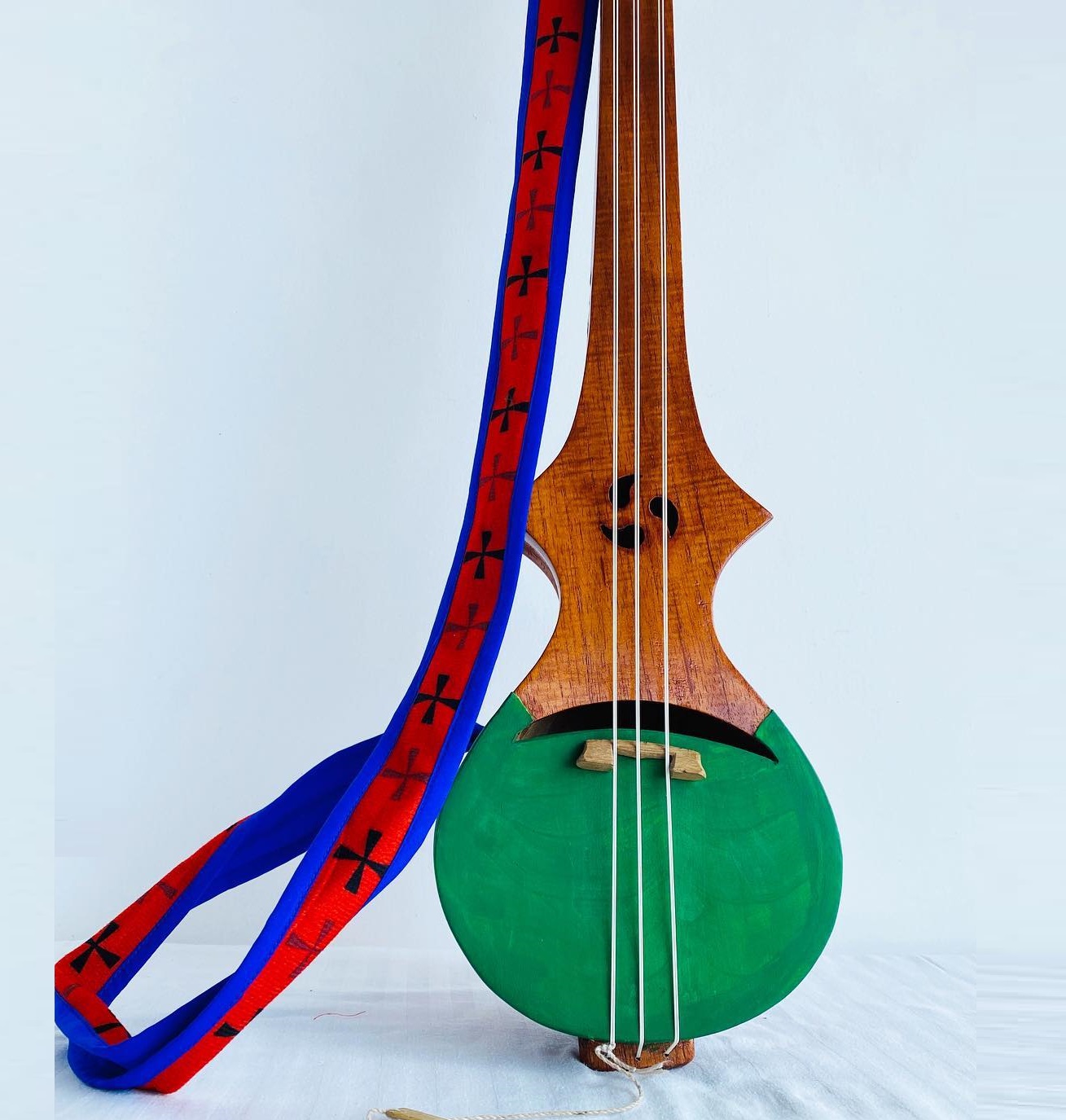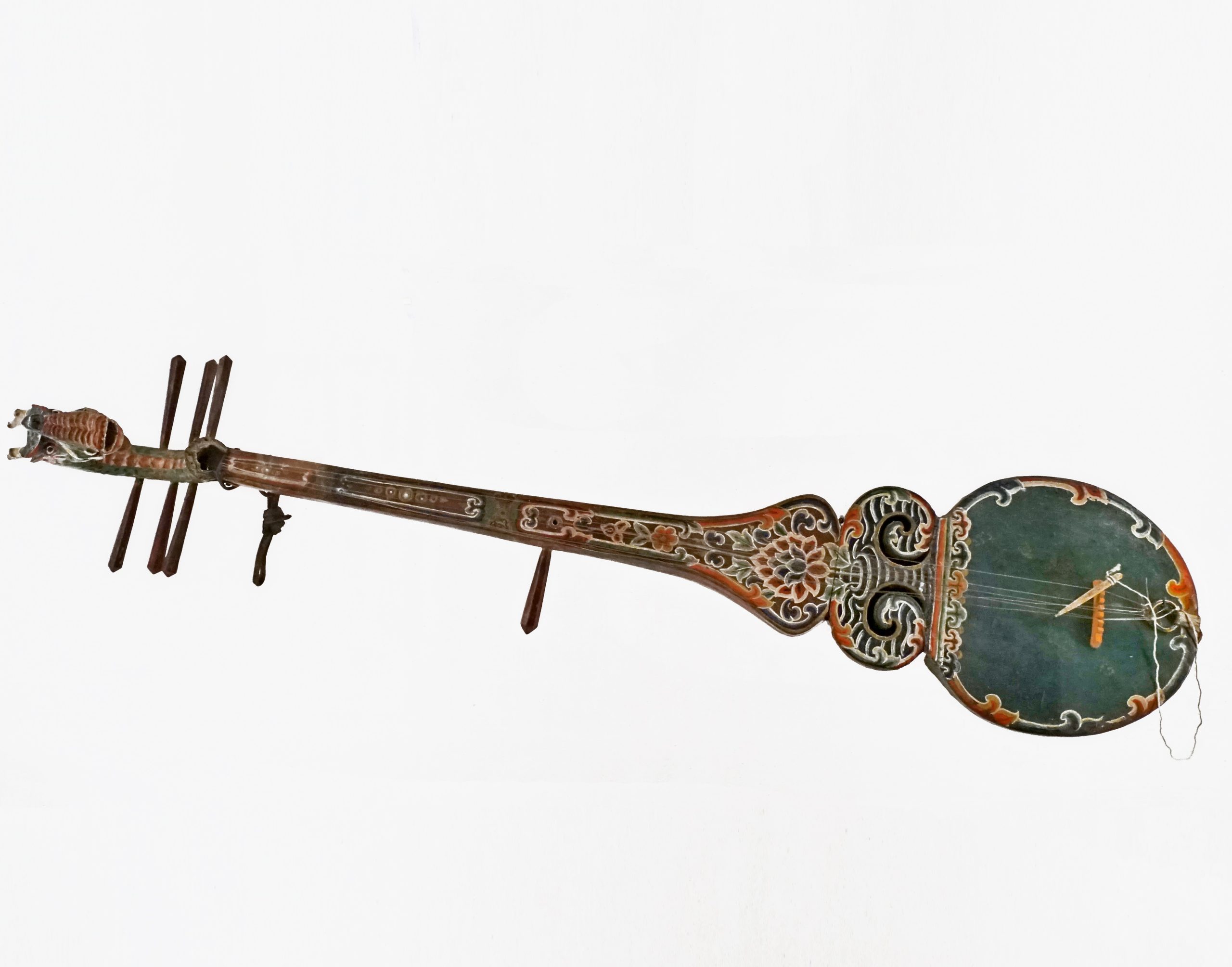Dranyen
Plucked Instruments
Asia
Between 1001 and 1900 AD
Video
The Dranyen is a traditional stringed instrument originating from Tibet and widely used in the Himalayan region. It belongs to the lute family and is known for its distinctive long-necked design, deep resonant sound, and cultural significance in Tibetan folk and religious music. Often played with a plectrum, the Dranyen produces a bright and percussive tone that is both melodic and rhythmic. The instrument is traditionally used for accompaniment in folk songs, dances, and religious ceremonies, making it an essential part of Tibetan and Bhutanese musical heritage.
The Dranyen falls under the category of chordophones, specifically a long-necked lute. As a stringed instrument, it produces sound through the vibration of its strings, which are plucked using a plectrum or fingers. Unlike a bowed instrument such as the violin, the Dranyen relies on the plucking technique to generate its unique tonal quality. It is typically classified as a fretted, hollow-bodied lute with a wooden construction and a skin or wooden resonating surface.
History
The origins of the Dranyen trace back to the Tibetan Plateau, making it an integral part of the region’s musical traditions for centuries. While the exact date of its invention remains uncertain, historical evidence suggests that it emerged during the medieval period, possibly between the 10th and 15th centuries. The instrument likely evolved from Central Asian and Indian lutes, adapting unique Tibetan characteristics over time. The Dranyen became popular across Tibet, Bhutan, and parts of Nepal, where it is used in traditional folk and monastic music.
In Bhutan, the instrument is known as the “Drangyen” and holds an important place in religious and secular music. The Bhutanese Drangyen, often adorned with elaborate carvings, is used in both traditional storytelling and monastic ceremonies. The instrument also shares similarities with the Chinese pipa and Persian setar, indicating possible influences from ancient trade routes connecting Tibet to other cultural centers in Asia.
Construction and Design
The Dranyen is crafted primarily from wood, with traditional varieties featuring a carved wooden body and a long, narrow neck. The body of the instrument is typically made from a single piece of wood, hollowed out to create a resonating chamber. This design enhances the instrument’s sound projection and tonal quality. Some variations include an animal skin membrane stretched over the soundboard to amplify resonance, while others feature a fully wooden top. The back of the body is often rounded, contributing to the deep and rich tonal character of the instrument.
The neck of the Dranyen is relatively long and may be adorned with decorative elements, such as inlays, carvings, or painted motifs. Frets are embedded along the neck, allowing players to produce different pitches and melodic variations. The headstock is often elaborately carved, with Bhutanese versions featuring an intricate dragon’s head, symbolizing cultural and spiritual significance.
Strings on the Dranyen are traditionally made of gut or silk, though modern adaptations often use nylon or metal strings. The instrument typically has six or seven strings, arranged in three to four courses, which are plucked with a plectrum or fingers. The tuning pegs are positioned at the headstock, allowing for adjustments in pitch and tonal quality.
Types of Dranyen
There are several variations of the Dranyen, depending on regional influences and design modifications. While the Tibetan and Bhutanese versions share fundamental characteristics, they differ in aesthetic and construction details.
Tibetan Dranyen: This version is widely used in Tibet and has a more straightforward construction with minimal decorative elements. It often features a wooden or skin-covered soundboard and a simple headstock design.
Bhutanese Drangyen: This variation is more ornate, featuring elaborate carvings, especially the dragon-headed pegbox. It is commonly used in Bhutanese folk music and religious performances, symbolizing cultural pride and artistic craftsmanship.
Nepalese Variations: Some instruments resembling the Dranyen can be found in Nepal, where they incorporate elements of both Tibetan and Indian stringed instruments. These variations may include different tunings and additional strings.
Characteristics
The Dranyen is known for its unique tonal properties, which combine bright, percussive attack with a resonant sustain. Its characteristic sound comes from the combination of wooden construction, string arrangement, and playing techniques. The instrument has a relatively lightweight build, making it portable and easy to handle during performances.
One of the most distinguishing features of the Dranyen is its melodic and rhythmic versatility. It is often played in combination with vocal performances, where the plucked notes provide harmonic support to the singer’s voice. In ensemble settings, the Dranyen can serve as both a rhythm and lead instrument, depending on the style of performance. Another notable characteristic is its tuning system, which varies depending on the region and musical tradition. While there is no standardized tuning, common tunings include open chords or modal scales that complement Tibetan and Bhutanese folk melodies. The instrument’s playability is further enhanced by its fretted neck, which allows for precise pitch control and melodic expression.
The Dranyen’s cultural symbolism is also significant. In Bhutan, the dragon-headed Drangyen represents strength, wisdom, and artistic refinement. The instrument is often associated with traditional storytelling, where musicians use it to accompany epic tales, religious narratives, and historical accounts.
Playing Techniques
Playing the Dranyen involves a combination of plucking, strumming, and rhythmic techniques. Traditionally, musicians use a plectrum made of wood, horn, or bone to pluck the strings, though some performers prefer to use their fingers for a softer, more nuanced sound.
Common playing techniques include:
Plucking: Each string or course of strings is plucked individually to produce clear, melodic notes.
Strumming: Rapid strumming patterns create rhythmic textures and dynamic accompaniments for songs.
Hammer-ons and Pull-offs: These techniques allow for expressive melodic ornamentation, adding fluidity to musical phrases.
Sliding: Players slide their fingers along the frets to create smooth transitions between notes.
In traditional Tibetan and Bhutanese music, Dranyen players often accompany vocalists, providing harmonic support and rhythmic foundation. The instrument is also used for solo performances, where its expressive potential is fully explored through intricate melodic improvisations.
Maintenance
Proper maintenance of the Dranyen ensures its longevity and optimal performance. Key maintenance practices include:
- String Care: Regularly changing and tuning the strings to prevent breakage and maintain sound quality.
- Wood Preservation: Keeping the instrument in a dry, stable environment to avoid cracks or warping.
- Fret and Fingerboard Cleaning: Wiping down the frets and fingerboard to remove dirt and oils from playing.
- Storage: Using a protective case to shield the instrument from dust, humidity, and physical damage.
Applications in Music
The Dranyen is used in a wide range of musical contexts, from folk performances to religious rituals. In Tibetan and Bhutanese traditions, it is often played alongside singing and dancing, providing rhythmic and harmonic support. The instrument is a staple in Tibetan opera, where it accompanies dramatic storytelling and elaborate stage performances.
In monastic settings, the Dranyen is sometimes used in Buddhist chants and prayers, though it is more commonly found in secular entertainment. Folk musicians frequently incorporate the instrument into festivals and celebrations, showcasing its vibrant and rhythmic qualities. In recent years, the Dranyen has found a place in fusion music, blending with contemporary genres such as rock, jazz, and world music. Some artists have adapted it for modern ensembles, bringing its distinct sound to global audiences.
Most Influential Players
Several musicians have played a significant role in popularizing the Dranyen both within and beyond the Himalayan region. Renowned Tibetan and Bhutanese folk musicians have kept traditional Dranyen music alive through recordings and performances. Notable figures include Namgyal Lhamo, a Tibetan singer known for her contributions to folk music, and Jigme Drukpa, a Bhutanese artist who has extensively promoted traditional Bhutanese music. Contemporary artists experimenting with the Dranyen have also emerged, integrating it into innovative musical projects. These musicians have helped maintain the instrument’s cultural relevance while introducing it to new audiences worldwide.
Maintenance and Care
Proper maintenance is essential for preserving the Dranyen’s quality and longevity. The instrument should be stored in a stable environment, away from extreme temperatures and humidity, which can damage the wood and strings. Regular tuning and string replacement are necessary to maintain optimal sound quality.
Cleaning the Dranyen involves wiping it down with a soft cloth to remove dust and moisture. If the instrument has a skin-covered soundboard, extra care must be taken to prevent cracking or warping. Periodic inspections of the frets and tuning pegs help ensure smooth playability. Musicians often apply natural oils to the wood to prevent drying and maintain its luster. For those using electronic pickups, proper cable management and occasional checks of the amplification system are recommended.
Cultural Significance
The Dranyen holds deep cultural and symbolic significance in the Himalayan region. It is not merely a musical instrument but also a representation of tradition, spirituality, and communal identity. In Tibetan and Bhutanese folklore, the Dranyen is often depicted as an instrument of joy, played during celebrations and festive gatherings. The instrument is also associated with Buddhist teachings, as it is used in religious storytelling and moral education.
Beyond its traditional role, the Dranyen has become a symbol of resilience and cultural preservation. In the face of modernization and globalization, musicians and cultural practitioners have worked to keep Dranyen music alive, ensuring that younger generations continue to learn and appreciate this heritage. As a bridge between past and present, the Dranyen remains an enduring testament to the rich musical traditions of the Himalayan people.
FAQ
What materials are used to construct a Dranyen?
The Dranyen is typically made of wood, often from pine or walnut for the body, with a stretched animal skin or wooden soundboard. The strings are usually made of nylon or gut, and traditional models may have metal frets and decorative carvings.
How is the Dranyen played?
The Dranyen is played by plucking or strumming its strings using a plectrum or fingers. It is commonly played with rhythmic patterns, incorporating drone notes and melodic lines, often used in folk and religious music of Tibet and Bhutan.
What are the unique features of the Dranyen?
The Dranyen has a long, fretted neck and a distinctive, curved pegbox. It usually has six strings in three double courses and produces a bright, resonant sound. Some variations have an extended body shape for enhanced resonance.
 Links
Links
References
- Dramyin - Wikipedia
- Dra-nyen(Tibetan Lute) Lesson # 2 in ENGLISH ... - YouTube
- dranyen: a study in tibetan identity - Tibet Policy Institute
- Dra-nyen(Tibetan Lute) Lesson # 7 in ENGLISH/Tibetan ... - YouTube
- Traditional Tibetan Dra-nyen with Accessories
- Dra-nyen(Tibetan Lute) Lesson # 12 in ENGLISH language - YouTube
Other Instrument
Categories



















